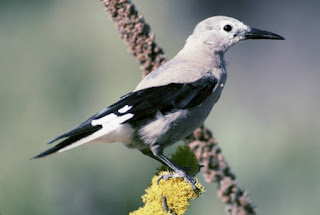The Surprising Clark's Nutcracker
For most people, a nutcracker probably brings to mind a metal or wooden device, or a soldier-like thing with big teeth, to crack the shells of nuts. It is also a genus of birds having three known species. They like to pluck nuts from pinecones, and our focus is on Clark's Nutcracker.
Sometimes it is called the woodpecker crow. It is not closely related to woodpeckers, but that is an understandable mistake because of the long, pointed beak. The behavior and ecological importance of this bird is...truly amazing.
 |
| Clark's Nutcracker, USFWS / Dave Menke (usage does not imply endorsement of site contents) |
Corvidae, such as jays, crows, magpies, and such, are surprisingly intelligent. Nutcrackers are in the same family, and their call is crow-like. They are designed to pick out the seeds they want, but they also plant them — and remember where they put their stashes for wintertime use. Like squirrels bury more nuts than they can ever retrieve, not all seeds planted by Clark's Nutcracker are eaten, thus helping in seed dispersal. A cousin of this nutcracker, the Eurasian Jay, also has a mutually-beneficial relationship with the European oak.
They like seeds from the white bark pine (and occasionally peanuts with fava beans and a nice Chianti). This tree is endangered by disease and beetles, and when the tree suffers, so does Clark's Nutcracker. The trees are important in many other ways to their ecosystems as well. The evolution-defying way Clark's nutcracker is designed to find, harvest, and spread seeds of the white bark pine speaks volumes of how the entire relationship was designed by the Master Engineer.
We often think of animals in terms of individual species, but many animals have mutually beneficial relationships with other animals and even with plants. The relationship between the Clark’s Nutcracker and the white bark pine tree is one such symbiotic relationship. Both can be found in the subalpine forest of the western United States and Canada. They are keystone species, meaning without these two species, the landscape would change.
. . .
The nutcracker’s pointed bill is the perfect size and shape to penetrate pinecones of the white bark pine, Pinus albicaulis, and other trees to extract seeds. This is because the pinecones of the white bark pine do not naturally open when the seeds are ripe. This means they are not dispersed by the wind like the seeds of many other trees, so the Clark’s Nutcracker is instrumental in spreading the seed. In return, the nutcracker is rewarded with the calorie-dense white bark pine seeds which form the bulk of its diet. The success of these two species is interconnected.
To read this extremely interesting article, fly over to "Masters of memory: Amazing birds help trees—with staggering feats of remembering." (Similar symbiosis is shown in "Cloaking the Bobtail Squid.") Although the following video contains a request for funding at the end, there is some excellent information and images of Clark's Nutcracker: